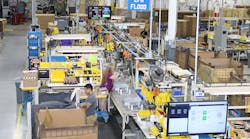The breadth of the program at Strategies in Light 2019 was truly amazing. You can get some idea of that range in the article covering featured speakers in this issue. Here, however, I want to discuss one particular panel that at first glance may have seemed on the fringe of the LED and solid-state lighting (SSL) sectors. The topic was 3-D printing and how that technology might impact or even revolutionize the lighting industry. That’s a hefty premise. And I wonder how you in the audience feel about learning more about 3-D printing.
I’ve followed 3-D printing from afar. Mainly I have thought of it as a great prototyping tool. But Nadarajah Narendran, director of research at the LRC (Lighting Research Center), and five panelists certainly made the point that additive manufacturing has the potential to bring far more benefit to SSL product development.
The present SSL supply chain is anything but efficient and environmentally friendly. It typically involves shipping sub-assemblies or even end products around the world. Goods may need to be stored multiple times and inventory is a cost sink.
In a perfect world, additive manufacturing could eliminate much of the storage and transportation and possibly even inventory with just-in-time delivery. The lighting industry could manufacture products onsite with lighting design melded into the building architectural design process.
Those are big concepts, but are they practical? I really don’t know. My first thought was that the concept sounded great, but surely compromises would be inevitable in terms of the end product.
The panelists, however, delivered case studies where the results were anything but a compromise. One example was a simple mounting bracket. The usual approach would be a subtractive process such as milling. A move to 3-D printing slashed the price of the component from $22 to less than $6 and weight from 355g to 55g.
Now I know it’s easy to find simple examples that can skew any comparison. But what impressed me was the discussion of how the technology can be applied, and is already being applied in SSL. One example was the body of a replacement lamp made on a 3-D printer with the additive material also serving as a heat sink. It turns out that there is a real possibility that additive manufacturing can improve the aesthetics and functionality in some LED-based lighting products.
Clearly, advanced injection molding will prevail over 3-D printing for truly high-volume products in terms of sub-assembly cost. You do, however, have to consider every aspect of such a tradeoff including environmental impact. Moreover, the full ability to customize lighting to a building project may deliver benefits we just don’t understand today.
So my question is: How much time and resources should I spend on 3-D printing in the near term? A decade ago, I could not have believed the breadth of technology that we’d be covering relative to LEDs — lighting for health, connected lighting, horticulture, autonomous vehicles, and more.E-mail me at [email protected] and let me know your thoughts. I have leads on a couple of contributed article possibilities on the topic. And a webcast is a possibility. Would you like to see that content from us?
Maury Wright,
EDITOR
[email protected]





